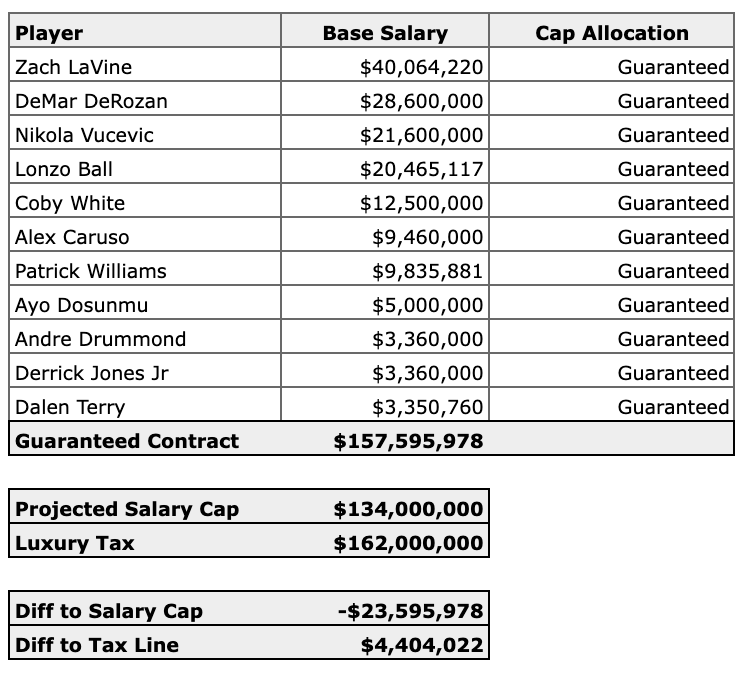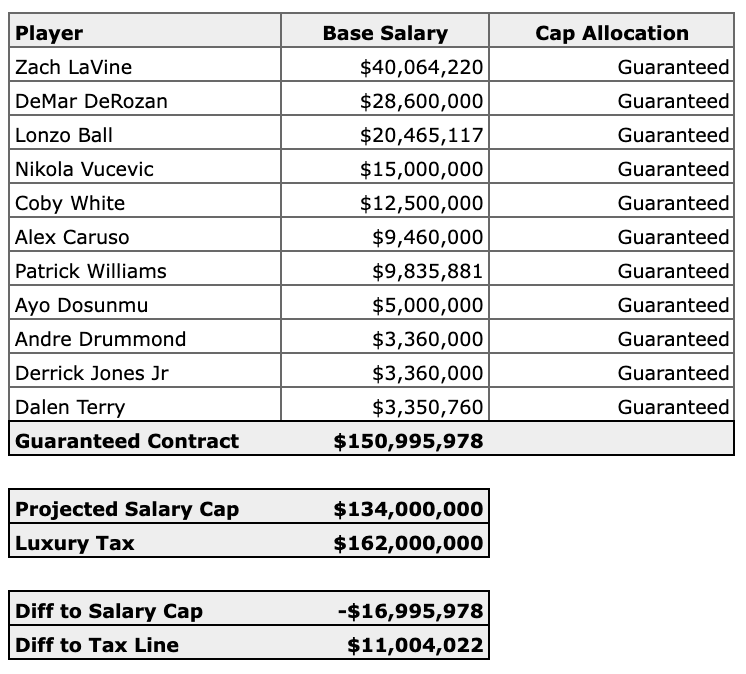© 2025 ALLCITY Network Inc.
All rights reserved.

Arturas Karnisovas said a lot during his season-ending press conference on Saturday.
The prevailing takeaway?
Expect more of the same.
Sure, there may be some tweaks here and there. Karnisovas addressed the team’s lack of 3-point shooting and the desire to add more size and brawn to minimize opponent second-chance points.
But as Karnisovas noted, his offseason priority is to retain soon-to-be free agents Nikola Vucevic (unrestricted), Coby White (restricted) and Ayo Dosunmu (restricted), and continuing progressing with the same core group of players.
Recommitting to this team, one which could only muster a 40-42 record, leads to a series of questions.
In this post, I want to breakout the spreadsheets and address the Bulls’ current and projected salary cap position.
You’ll soon see why keeping the same playing group together and adding quality free agents — and skirting below luxury tax thresholds — isn’t possible.
Current Cap Position
Here’s a breakdown of the Bulls’ current active contracts and cap holds.

At present, the Bulls have over $190 million committed to its players, including cap holds.
The projected salary cap for the 2023-24 season is currently projected to be $134 million.
Before the offseason begins, the Bulls will be operating over the cap.
Yes, as we move closer to July, and decisions are made on certain players, there will be some movement in these numbers. However, as of today, based on those players who represented the Bulls this season, the team will be over the salary cap, meaning they won’t have cap space to use on free agents.
Projected Cap Position
Before we dive into it, I wanted to make it clear that the following calculations are based on my assumptions on what Karnisovas has said to date.
It should be noted that the Bulls don’t control the rights to all of their free agents, namely Nikola Vucevic. Therefore, even if the plan is to bring it all back, Vucevic has a say in the matter.
Should the center choose to leave Chicago, it dramatically changes the on-court product, but also cap projections.
With that disclaimer out of the way, let’s assume the following:
- The Bulls, Vucevic agree on a new 3-year, $70 million deal
- White explores restricted free agency and is retained for 3-years, $40 million
- Donsunmu signs a 2-year, $10 million deal
- Andre Drummond, Derrick Jones Jr. opt into the final year of their respective deals
- Bulls keep all other guaranteed contracts
Should the above scenario occur, the Bulls will have $157.6 million committed to 11 players.

As noted, the salary cap is projected to be $134 million. The luxury tax line, that which the Bulls have routinely avoided, will be set at $162 million.
In the above scenario, the Bulls will be well over the cap and, importantly, only $4.4 million under the luxury tax.
Another assumption, but a safe one: Jerry and Micahel Reinsdorf are not going into the luxury tax for this team. If this mandate is enforced, it means the Bulls will only be left with $4.4m to fill out the remainder of the roster.
Given the overwhelming need for shooting and frontcourt size, how can these problem be solved with so few resources if the punitive tax line won’t be crossed?
It can’t.
Therein lies the problem. So long as ducking the tax remains a priority, the Bulls can’t re-sign their free agents to market-value deals and address their biggest roster flaws.
The math doesn’t add up.
Of course, this is all based on the contract numbers which I’ve posited for the Bulls’ pending free agents. I think these figures are reasonable. In actuality, though, perhaps the Bulls and their players negotiate team-friendly deals?
It’s a possible scenario, one that is particularly relevant to Vucevic.
As it stands, there won’t be many teams who will have cap space in the offseason, and those that do, are young, rebuilding teams.
Vucevic doesn’t fit the timelines of these teams, and, because of this, his leverage in negotiations may be weakened. Using this market dynamic to their advantage, perhaps the Bulls can strongarm Vucevic into a deal which pays him something closer to $15 million per season?
Even so, assuming all other assumptions remain as is, Vucevic signing for less doesn’t materially change the Bulls’ cap position.

The Bulls have more scope to finalize their roster with an $11 million delta to the tax line, compared to $4.4 million.
Still, the math doesn’t add up.
$11 million is equivalent to the Mid-Level Exception (MLE). A good, meaningful player could be had with this amount. But so long as avoiding the tax remains a mandate, the Bulls don’t have the means to sign a player to a MLE type deal and fill out the rest of the roster — doing so will most certainly push the Bulls over the tax line.
The more likely scenario would be to distribute any available money ($11 million) across four roster spots. This is the only way the Bulls can stay under the tax and field a complete team.
Of course, splitting this money over multiple contracts won’t net the Bulls anything more than end-of-bench veterans. This caliber of player isn’t markedly improving the Bulls’ shooting woes and, ultimately, propelling the franchise up the Eastern Conference standings.
Even if the Bulls have the means to bring everyone back, they can’t afford it.
Not if escaping mediocrity is the goal.
Get Chicago's Best Sports Content In Your Inbox!Become a smarter Chicago sports fan with the latest game recaps, analysis and exclusive content from CHGO’s writers and podcasters!
Just drop your email below!
Comments
Share your thoughts
Join the conversation


